After two quarters of Bordeaux dominance, the latest trading volume data has room at the top for one non-Bordeaux wine. Among the five wines with the greatest incremental increase in trading volumes for the period of January-December 2017 (calculated using figures collated by Wine Market Journal from sales at the world’s major auction houses), sits Louis Roederer’s Cristal in second place.
Volumes of Cristal traded increased by 267 bottles, helped along by a Sotheby’s auction in New York in November where 37 bottles went under the hammer. While this translates into a small Economics score increase of just one point, the wine nevertheless holds the highest overall Wine Lister score of the five at 975/1000.
Château Pavie appears high up the list for a consecutive quarter, with a further 228 bottles added to its trading volume count compared to October 2016-September 2017. Though in third place for incremental change, Pavie has the highest overall volume of bottles traded of the top five (2,466).
The number one spot for increased trading volumes is taken by Château Pape Clément, with 293 more bottles traded over the course of 2017 compared to the previous dataset period. Pape Clément has the lowest Quality score of the top five (825), however high Economics (952) and Brand (960) scores pull the overall score up to 898.
Château Calon Ségur and Château Troplong-Mondot fall in fourth and fifth place for biggest change in trading volumes.
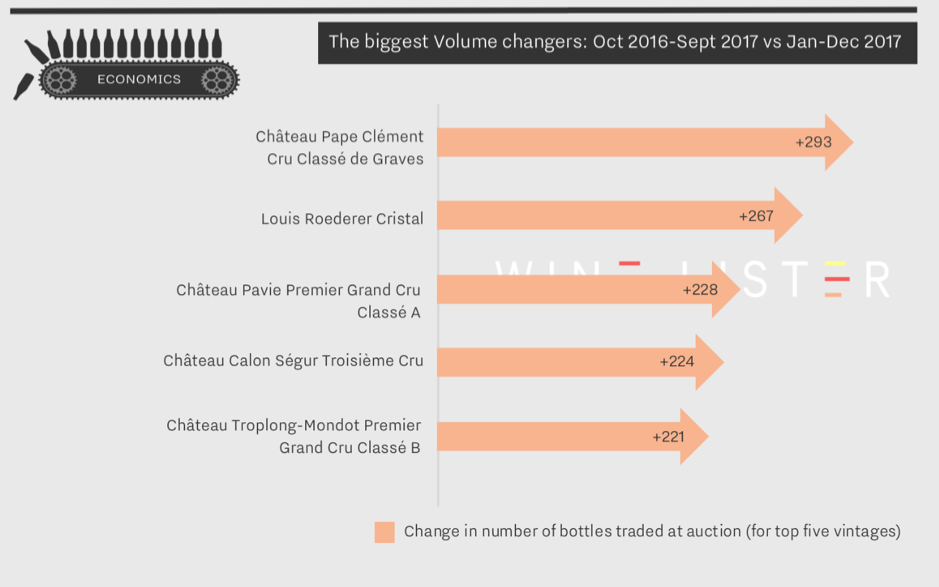
It is interesting to note that Larrivet Haut-Brion Blanc has the highest growth of Economics score, moving up a huge 376 points since Q4 2016, to 669. With the recent spike in trading volumes of the red (as seen in our last analysis), trading volumes of the château’s wines are increasing across the board.
After a distinctly Burgundian start to 2018, we are ringing the changes this week to look at some of our most improved Brand scores, with Champagne dominating.
Alongside presence in the world’s best restaurants, Wine Lister’s Brand score measures a wine’s online popularity – as indicated by the number of searches received on Wine Searcher – as a marker of real consumer demand.
The search frequency data for December is in, and it is no surprise that searches in Champagne increased significantly leading up to the Christmas period.
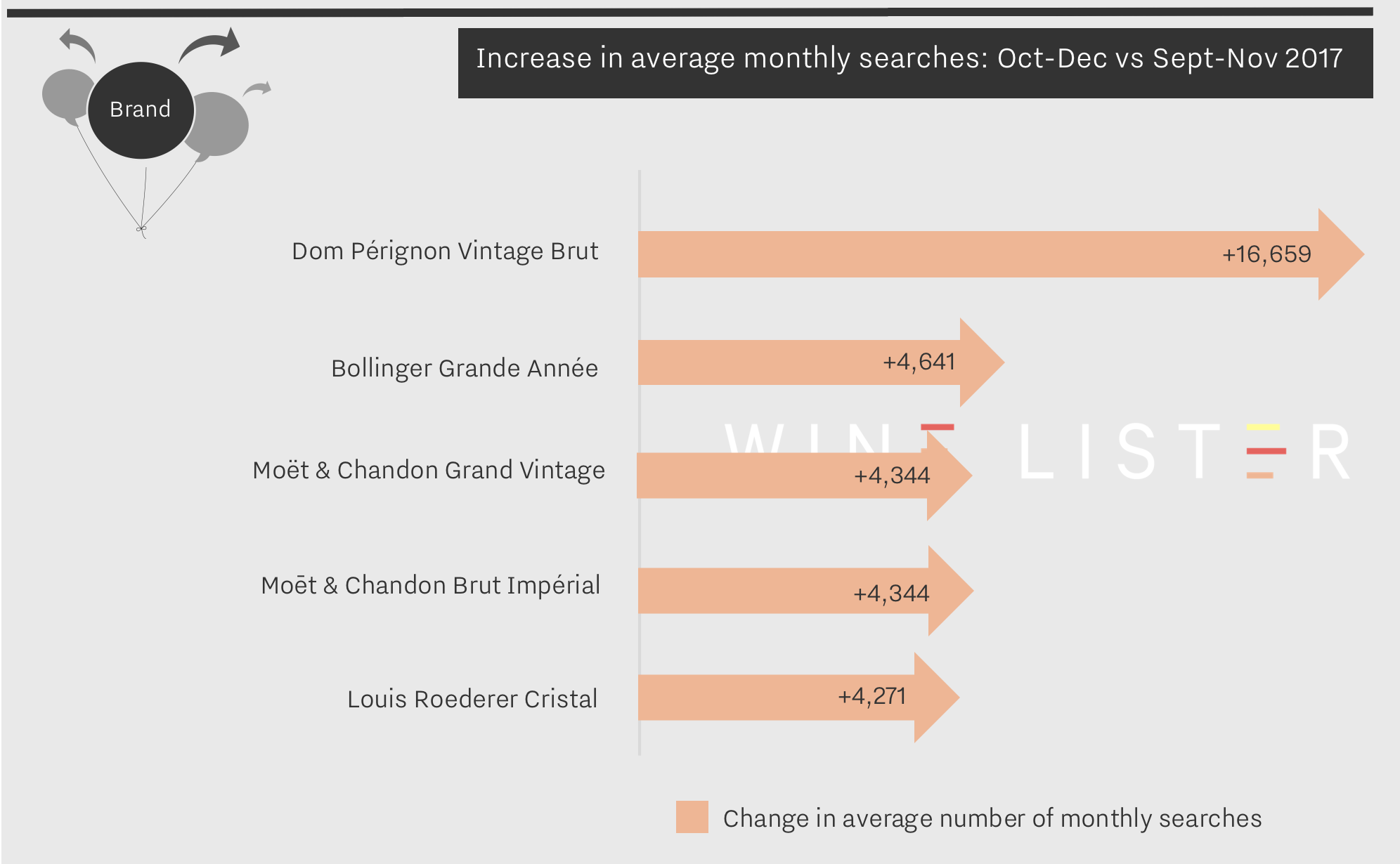
During arguably the busiest period of the year for searching and purchasing wines, these five wines gained between 20% and 77% increase in search frequency. The appearance of Dom Pérignon Vintage Brut at the top of search frequency lists is a shock to no one considering its position as one of the most searched-for wines of all time. Indeed, it consistently held the number one search spot from July to September last year. The Christmas influence still managed to add 16,659 online searches, allowing this almighty brand to achieve Wine Lister’s first ever perfect Brand score (1000)!
Next on the list is Bollinger Grande Année. Its impressive 77% increase in search frequency at the end of last year can also be attributed to the festive season, but may also have been boosted by the release of the 2007 vintage earlier in the year. Bollinger’s new Brand score is up 16 points on the previous quarter at 975.
Our next two appearances hail from the same owner as the first, Champagne divinity LVMH. Moët & Chandon, often considered the definitive Champagne brand holds not one, but two spots in the top five most searched for wines of the last three months. Moët & Chandon Grand Vintage is perhaps a classic Christmas choice, but the appearance of a non-vintage cuvee, the Moët & Chandon Brut Impérial is testament to the power of the Moët & Chandon brand. Each earned an increase in search frequency of 33%, bringing Brand scores to 987 and 938 respectively.
Last but not least, Louis Roederer Cristal takes fifth place with a search frequency increase of 20%. While achieving a fractional increase in searches (4,271) compared with Dom Pérignon, its presence in 54% of restaurants and consistent high quality (Quality score 970) makes Cristal an all-round achiever, and therefore a choice that’s not just for Christmas.
Champagne’s Brand prowess is clear, but these five are the shining stars of their region. It is interesting to note that the sixth most searched-for wine on our most recent list is in fact not a Champagne at all, but Château Margaux (Brand score 998).
Following on from our recent blog in which we looked at the five wines that enjoyed the greatest absolute increase in online search frequency during November, we thought it would be interesting to look at the five wines whose improved popularity had the biggest impact on their Brand score. This throws up some less obvious candidates.
Alongside presence in the world’s best restaurants, Wine Lister’s Brand score measures a wine’s online popularity – as indicated by the number of searches received on Wine Searcher – as a marker of real consumer demand. The five wines below do not come close to rivalling the phenomenal popularity of the first growths and company whose search frequency increased the most in absolute terms in November. However, the relative change in their online search frequency led to some significant improvements in their Brand scores.
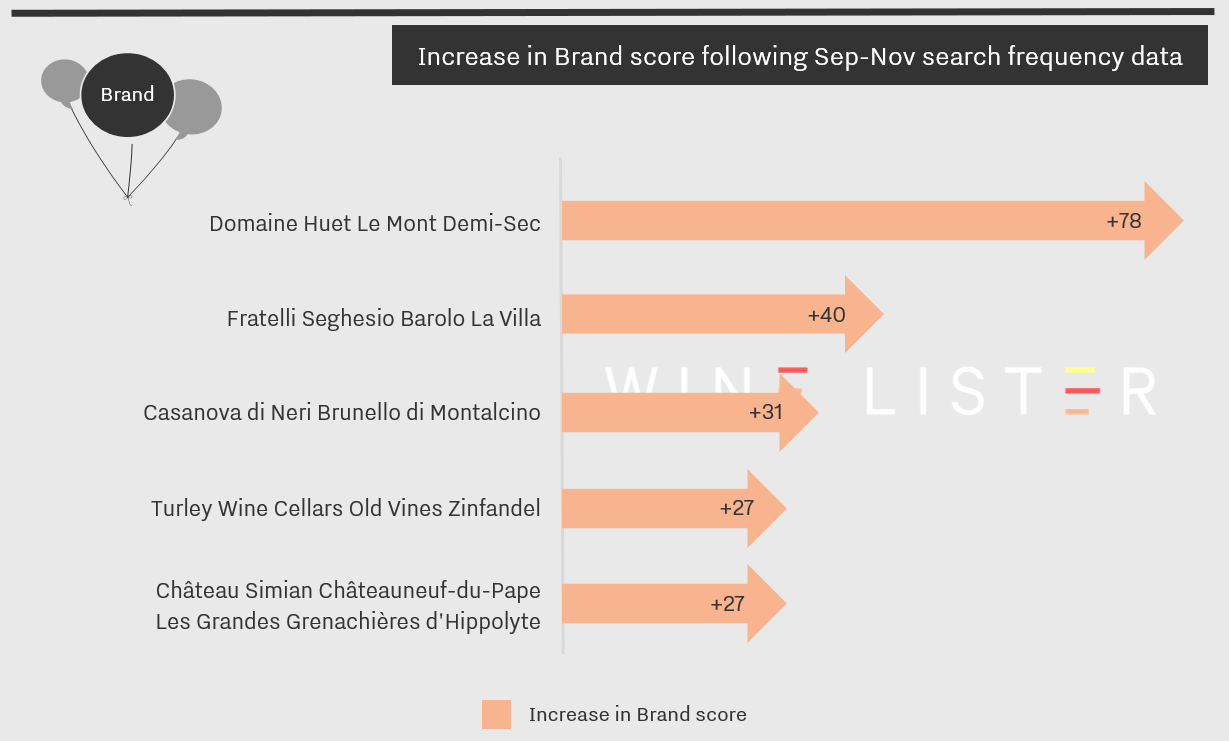
Whilst each of the five experienced an increase of at least 44% in their online search frequency, Domaine Huet Le Mont Demi-Sec’s surged 147% during November, resulting in a whopping 78-point gain in its Brand score (now 765), tipping it into the very strong category on Wine Lister’s 1,000 point scale. Its sharp increase in online popularity might be the result of the 2016 vintage being named the sixth best wine in the world by Wine Spectator last month. Whilst the 2016’s Wine Lister Quality score (917) can’t quite match the performance of two of Domaine Huet’s sweeter cuvées for the vintage, it appears that it is a brand on the up.
Next comes a duo of Italian reds – Fratelli Seghesio Barolo La Villa and Casanova di Neri Brunello di Montalcino. Starting from a low base of just 243 searches each month, the Piedmontese red’s search frequency leapt 63% to 396, resulting in a 40-point increase in its Brand score (506). In stark contrast, Casanova di Neri’s straight Brunello already benefitted from a high level of online popularity, previously receiving 1,791 searches each month on average. It’s 72% increase in search frequency – again presumably thanks to the 2012 vintage’s fourth spot in Wine Spectator’s top 100 wines – has resulted in a new Brand score of 799, the highest of the group.
Last but not least, Turley Wine Cellars Old Vines Zinfandel and Château Simian Châteauneuf-du-Pape Les Grandes Grenachières d’Hippolyte both enjoyed a 27-point increase in their Brand score with the latest search frequency data. Whilst their overall Wine Lister scores are fairly similar (605 and 577 respectively), their profiles differ markedly. The Californian red performs best in the Brand category, its new score of 650 comfortably outperforming its Quality and Economics scores (593 and 552 respectively). Conversely its Old-World peer has a weak brand (327), well below its very strong Quality score (808) and average Economics score (498).
It will be interesting to see if these brands continue to strengthen in 2018. Speaking of which, the Wine Lister team wishes you all a Happy New Year!
With the latest online search frequency data in from Wine-Searcher, we can see which wines rose in popularity during November. Each month we look at the last three months’ worth of search data, measured against the previous period, to see which wines have grown most in popularity. With five of the world’s six most popular wines making the greatest gains during November, it appears that demand for the biggest brands shows no sign of diminishing, and that the public is quick to pick up on announcements regarding the most famous fine wine producers.
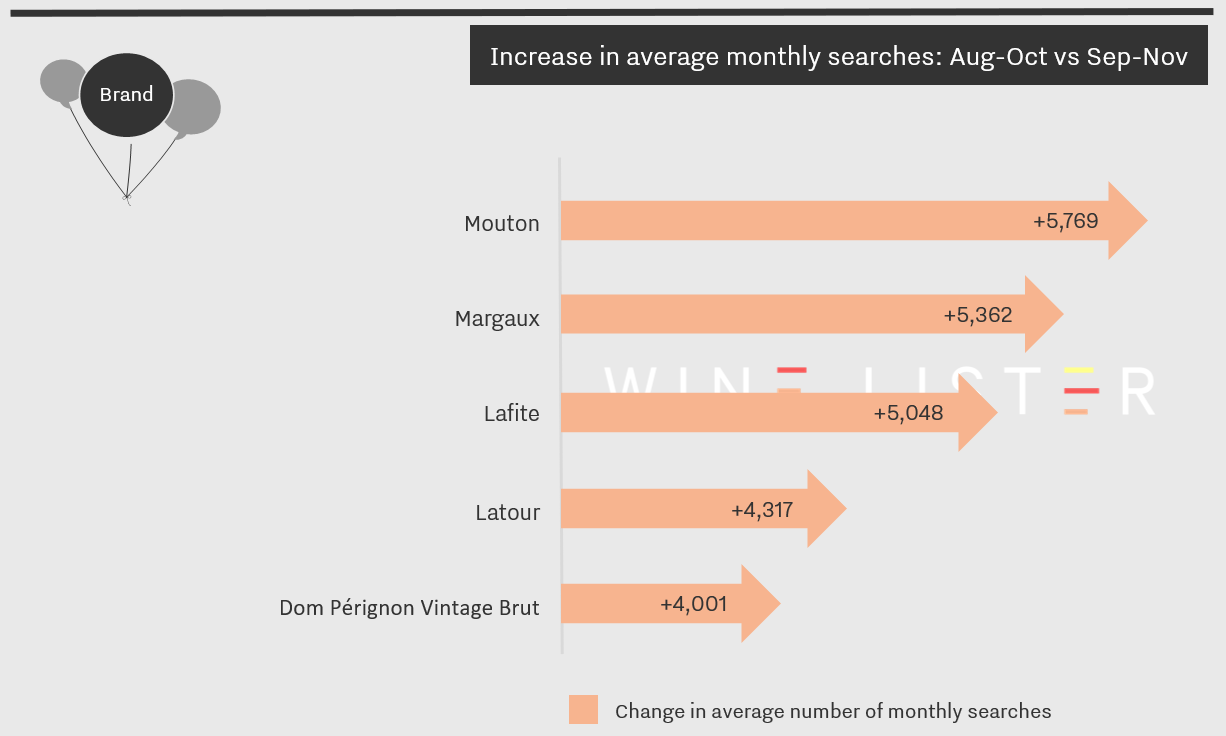
Mouton, the world’s second-most popular wine, made the greatest gains during November. This is likely thanks to the release of the label for the 2015 vintage. It features a witty juxtaposition of Gerhard Richter’s “Flux” with the reiteration of part of Mouton’s motto, “Mouton ne change” (Mouton never changes), in the context of a generational shift as Philippine de Rothschild’s three children take the helm after her death in 2014.
Snapping at Mouton’s heels was Margaux. It too announced during November that it will release its 2015 vintage in a commemorative bottle – the first time the château has done so – paying homage to Paul Pontallier who was winemaker at the property for almost 30 years. With Margaux 2015 achieving one the best Quality scores of the vintage, it seems a fitting tribute.
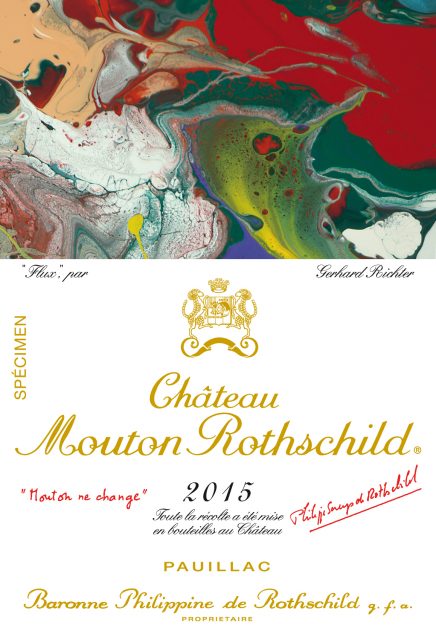
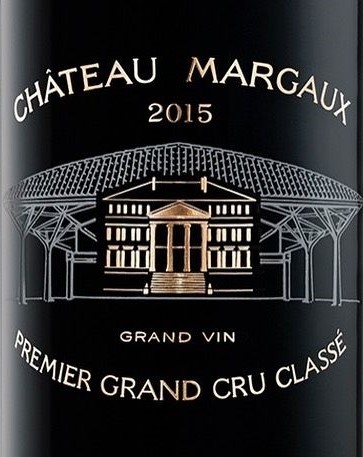
Lafite came next. In mid-November it was announced that in March 2018 Saskia de Rothschild will be taking over as chairwoman of the château and Jean-Guillaume Prats of Moët Hennessy will become President and CEO. With Lafite currently the most popular wine in the world, and one of just five wines on Wine Lister to achieve a Brand score of 999 – alongside Dom Pérignon Vintage Brut, Mouton, Latour, and Yquem (no wine scores 1,000) – the duo have a formidable reputation to maintain.
Latour was the fourth-biggest gainer, its search frequency increasing 8% (4,317 searches). Whilst the increased interest in the other Médoc first growths can be attributed to a significant announcement, the reason behind Latour’s surge in popularity is less obvious. Related news is of course the acquisition by Artemis Domaines – Latour owner François Pinault’s holding company – of Burgundian Grand Cru monopole Clos de Tart.
Breaking the Bordeaux first growths’ dominance on this month’s popularity stakes was Dom Pérignon, a brand whose online popularity has soared over the second half of the year. Early in November Moët Hennessy announced the launch of Clos19, an online shop selling its prestigious brands – one of which is Dom Pérignon. Cannily introduced before the festive season, during which Champagne’s popularity surges – it seems that the region’s strongest brand has further benefited from the new platform.
This week, our listed section journeys to the most northerly Burgundy appellation to look at Wine Lister’s top five Chablis by Quality score. Wine Lister’s Quality score comprises the average rating of our four partner critics, as well as a wine’s ageing potential.
In fifth place is Hidden Gem, Domaine Gérard Duplessis Chablis Grand Cru Les Clos. Producing only 1,500 bottles a year, this wine is present in just 2% of the world’s top restaurants, but receives a very strong rating from Jancis Robinson, setting its Quality score at 910.
Domaine William Fèvre Chablis Grand Cru Les Clos is fourth-highest with a Quality score of 927. Whilst Jeannie Cho Lee doesn’t score the wine as highly as our other critics, at £55 it still represents a lot of bang for your buck.
Bronze goes to Domaine Raveneau Chablis Grand Cru Valmur, with a Quality score of 946. The only wine of the group not from the Les Clos climat, it has a predicted drinking window of 10 years – higher than the rest of its peer group, which averages eight years.
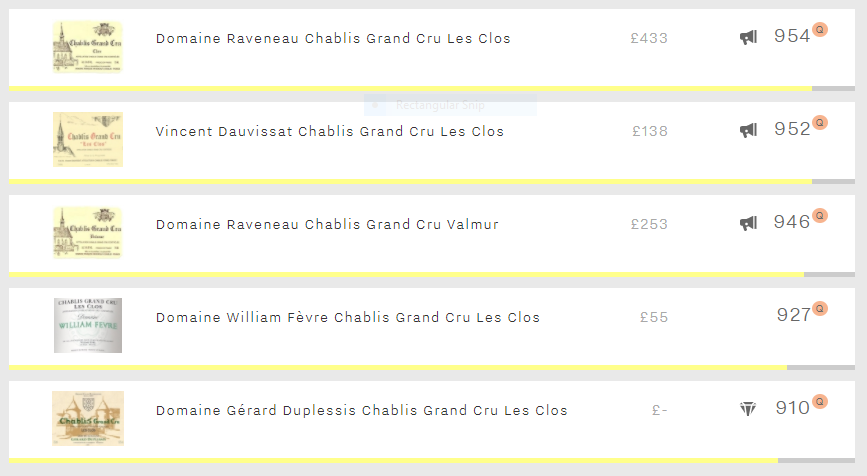
Vincent Dauvissat Chablis Grand Cru Les Clos has the second-highest Quality score (952) and also has the biggest variance in ratings from our partner critics, receiving an outstanding score from Jeannie Cho Lee, but a far more modest one from UK critic Jancis Robinson.
Winning the Quality score crown by a narrow two-point difference (954) is the second wine of the group from Raveneau – the domaine’s Les Clos offering. Enjoying uniformly excellent scores from each of our partner critics, it’s one of the most talked-about wines in the fine wine trade and unsurprisingly holds Wine Lister Buzz Brand status.
The latest three-month average search frequency data is in, and with it we can see which wines’ increase in popularity has boosted their Brand score. Here we focus on the five wines that saw the largest increase. All saw at least a 29-point rise in their Brand score.
Château Montviel saw the greatest increase, gaining 60 Brand points and taking its overall Wine Lister score to 523. Its average monthly search frequency of 1,085 remains its strongest criterion score, as its three-month average price (£31) and liquidity hold it back — it has failed to trade a single bottle at auction over the past year.
The second-highest increase was Campo Eliseo, whose Brand score rose 37 points to 453. Although it holds the lowest overall Wine Lister score of the group (490), it had the greatest surge in online surge frequency (+64%).
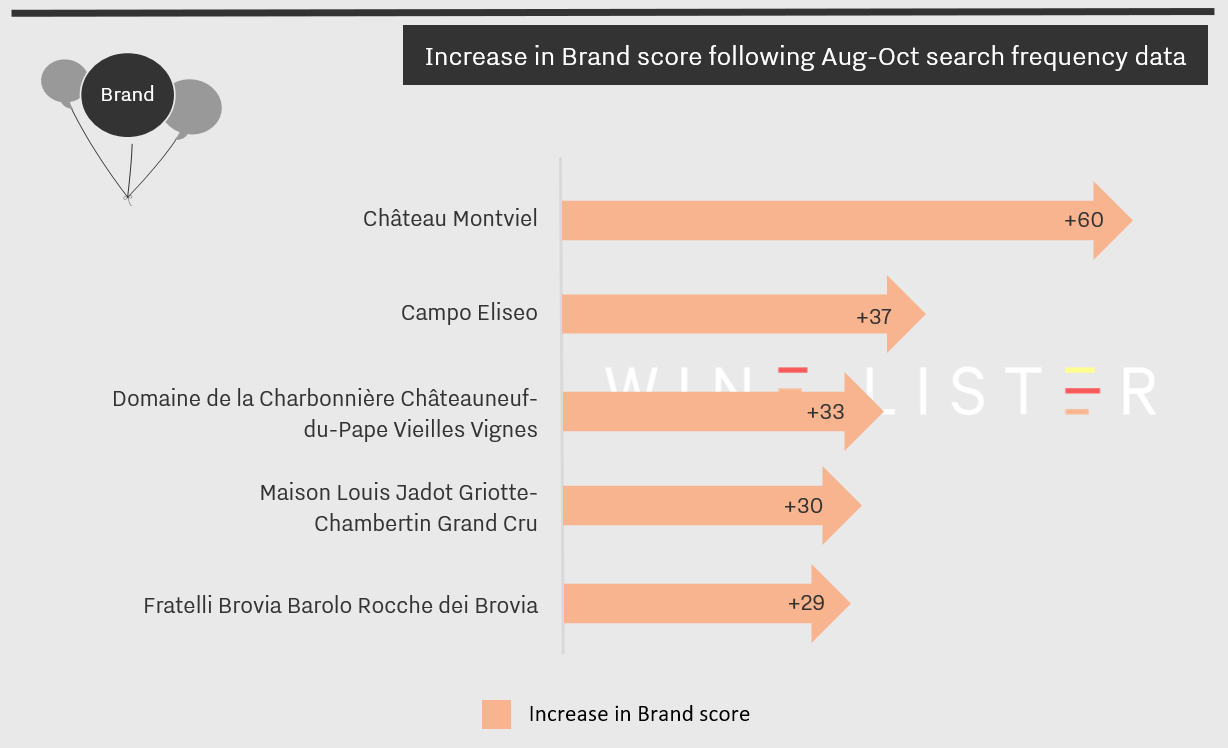
Following a drop in its price over the last six months, Domaine de la Charbonnière Châteauneuf-du-Pape Vieilles Vignes also saw a welcome increase in search frequency (+51%) and a subsequent Brand score increase of 33 points to 437, pushing its overall score towards the ‘Strong’ band on the overall Wine Lister scale (now just 17 points short at 583).
The fourth-highest increase, though still the with the lowest overall search frequency of the five (172 searches), is Maison Louis Jadot Griotte-Chambertin Grand Cru. Currently holding Hidden Gem status, is this an early sign that this wine won’t be under the radar for much longer?
Finally, Fratelli Brovia Barolo Rocche dei Brovia saw an increase of 29 Brand points to 654, following a 45% increase in search frequency. US partner critic Antonio Galloni rates it very highly, with the result that it achieves the highest overall Wine Lister score of the group (702).
So, with an impressive 10% increase in its Brand score this month, Château Montviel is the one to watch as we move in to the winter months.
For the second consecutive quarter, the five wines which saw trading volumes rise most were all from Bordeaux. Four of the wines below are big hitters, with overall Wine Lister scores ranging from 921 (Château Montrose) to 963 (Château Lafite Rothschild).
These top crus are also mainstays at global fine wine auctions, with over 2,000 bottles of the top five traded vintages of each wine selling at auction every year, and over 5,000 for Lafite. So, while auction trading volumes – a measure of liquidity – feed into a wine’s Economics score, none of the four has seen a significant enough increase to find their Economics score significantly changed.
There is one anomaly. Château Larrivet Haut-Brion has an average price of £23 per bottle, and from the period of July 2016 until June 2017 its top five vintages sold only 103 bottles at auction. At the end of last month, however, 228 bottles of the wine’s 2000 vintage were sold at a Bonham’s auction, making the wine the most popular of the day. The update to Larrivet Haut-Brion’s trading volumes has had a strong impact on its Economics score, which has risen from 567 to 667, and boosted its overall Wine Lister score from 663 to 684.
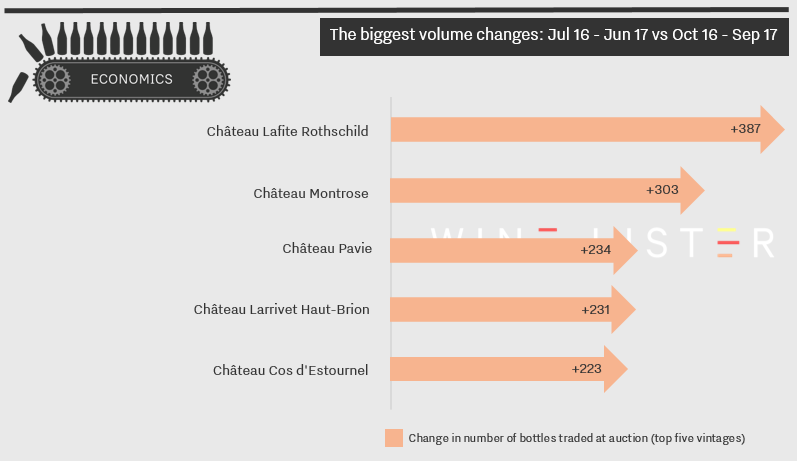
We calculate which wines have seen the greatest incremental increases in bottles traded by using figures collated by Wine Market Journal from sales at the world’s major auction houses.
Wine Lister’s holistic, dynamic rating system tracks a wine’s performance over time. By constantly analysing a wine’s brand strength and economic performance, as well as updating its Quality score as it is retasted by our partner critics, Wine Lister’s ratings evolve over time, as demonstrated by our new score history tool.
Wine Lister’s Economics score is a perfect case in point. Reacting to the very latest market data, it analyses a wine’s performance across several criteria: three-month average bottle price; short and long-term price performance; price stability; and liquidity. A strong showing across these criteria is what defines the five wines in this week’s Listed section – Bonnes-Mares’ top wines by Economics score.
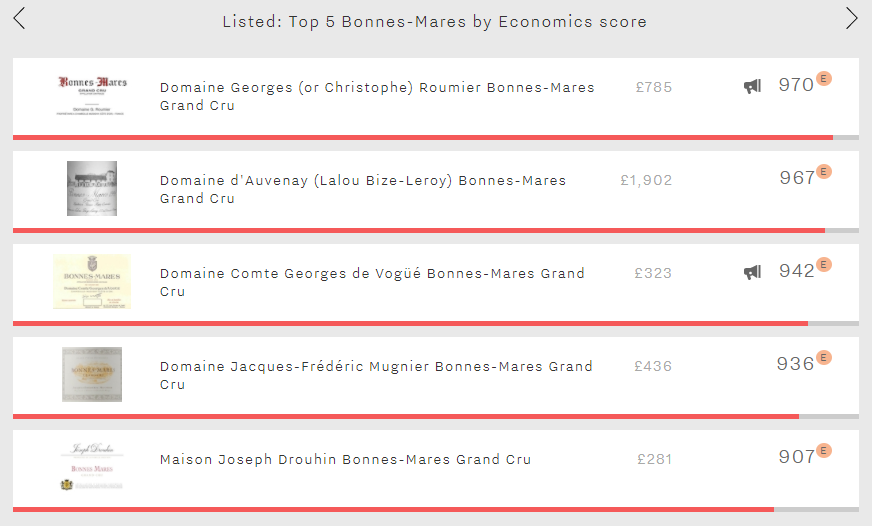
Whilst all five achieve Economics scores that put them amongst the very strongest on Wine Lister, it is Domaine Georges Roumier’s Bonnes-Mares that leads the way with an outstanding score of 970. It is the most liquid of the five, its five top-selling vintages having traded 414 bottles over the past four quarters.
In second-place is Domaine d’Auvenay’s Bonnes-Mares (967). Underlining the Queen of Burgundy’s continuing surge in demand, it has a remarkable three-year CAGR of 35.6% (nearly double that of Domaine Jacques-Frédéric Mugnier’s Bonnes-Mares, its closest rival in that criterion). Its price is the highest of the group by a considerable distance, at £1,902.
Domaine Comte Georges de Vögué fills the third spot with its Bonnes-Mares’ Economics score of 942. One of the group’s two Buzz Brands, it is the second most-traded of the five (327 bottles), and has strong short-term price performance, its price having increased 11.2% over the past six months.
The Bonnes-Mares from Domaine Jacques-Frédéric Mugnier and Maison Joseph Drouhin fill the last two spots. Whilst they display similarly modest levels of liquidity (having traded 63 and 68 bottles over the past four quarters respectively), Mugnier leads Drouhin thanks to its considerably higher price (£436 vs £281) and superior long-term price performance (three-year CAGR of 18.2% vs 13.9%).
And thanks to Wine Lister’s approach, these scores will continue to change over time, meaning that they are always relevant and reflect the wine’s evolving position in the market.
The annual spate of releases in September has influenced this month’s gainers in online search frequency. For the third consecutive month, Dom Pérignon Vintage Brut has seen the largest increase in average monthly searches, which we calculate using three-month data from Wine-Searcher measured against the previous period. Dom Pérignon 2009 was released in early September, and the wine’s increase of 5,154 searches is the largest incremental monthly increase seen this year, taking it to 60,241 average searches per month: the highest of any Champagne and fifth highest of all wines.
Following last month’s narrowing of regions within the top five (only two were featured), the breadth in September significantly increased, with icons from California, Bordeaux, Piedmont, and Chile joining Champagne. The number of searches has also increased dramatically after the summer slowdown, with 19 wines seeing an increase of over 1,000 average monthly searches. The release of Opus One 2014 at the beginning of September – judged “a gorgeous wine” by our partner critic Antonio Galloni – has boosted interest in this Napa Valley stalwart, with an increase of 4,651 searches taking it to over 40,000 searches per month.
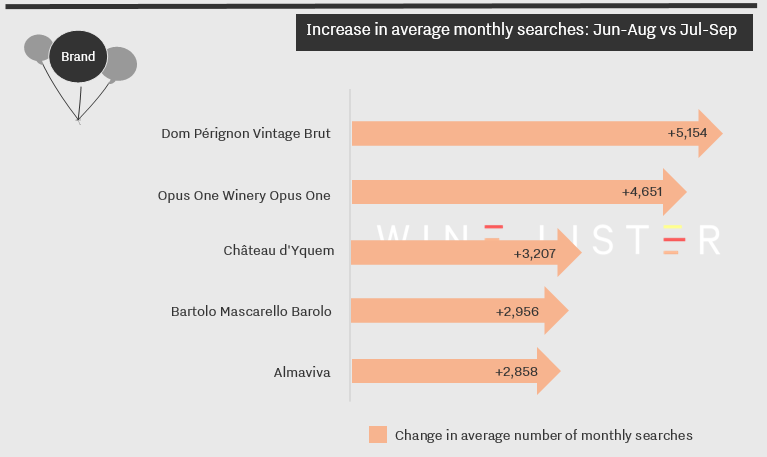
Château d’Yquem is another wine to see online search frequency rise on the back of a September release. The 2015 was released alongside Opus One 2014 at €250 ex-négociant.
The next in the table, Bartolo Mascarello Barolo, has the lowest search frequency of any of the wines above, with an average 10,075 per month. Nevertheless, with an overall Wine Lister score of 941/1,000 the wine is one of the great names of Barolo: the fourth best overall on Wine Lister.
Almaviva celebrated its twentieth anniversary in June, while its producer Viña Concha y Toro has recently entered the global ranking inside the Top 10 Beverages category within the Dow Jones Sustainability Index for the first time. With the release of Almaviva 2015 in early September adding to the interest, the wine has seen an increase of 2,858 online monthly searches, taking it to 11,291.
Champagne continues to find itself a popular tipple amongst summer drinkers, the latest Wine Searcher data shows. Each month we look at the last three months’ worth of search data, measured against the previous period, to see which wines have grown most in popularity. Last month’s data featured two Champagnes in the top five, and this month’s – looking at data from June to August – features three.
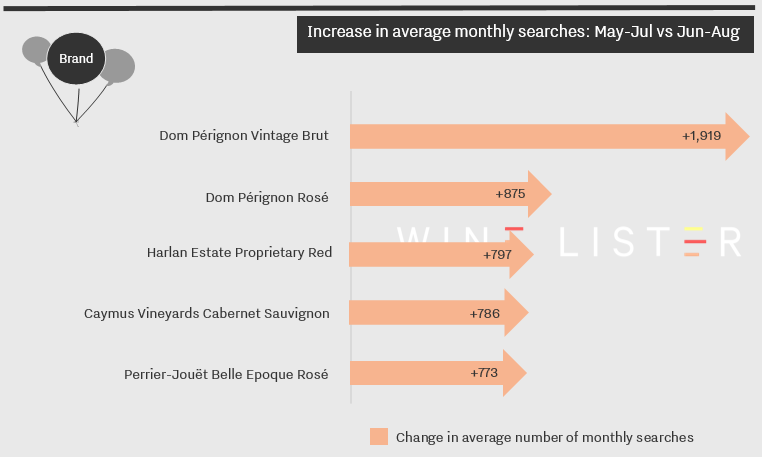
For the second month in a row, Dom Pérignon Vintage Brut finds itself in first place, with an increase of 1,919 searches taking the wine to an impressive 57,000 searches on average per month. This also makes it the fifth most searched-for wine on Wine Searcher from June to August, beaten only by Bordeaux heavyweights Lafite, Mouton, Margaux, and Petrus.
The producer’s Rosé takes the second spot, although with 9,300 searches on average per month it falls some way behind the dizzy popularity of its sibling. Proving the unquenchable appeal of drinking pink Champagne in the sun, Perrier-Jouët Belle Epoque Rosé makes up this month’s trio. Starting from the lowest number of average searches of the five wines, at around 1,600 per month, it jumps to 2,300 searches with the latest data update.
The breadth of regions has narrowed this month, with the remaining two wines both Cabernet-based and hailing from Napa: Harlan Estate Proprietary Red and Caymus Vineyards Cabernet Sauvignon. The former is one of the region’s biggest names, a self-proclaimed “First Growth” of California, costing on average £665 per bottle. Caymus Vineyards, meanwhile, averages £100 a bottle but is a favourite amongst consumers, and with an overall score of 747/1,000 shows that high quality doesn’t always come with a high price to match.
Champagne and Californian Cabernets: the drinks of the summer. You heard it here first.











